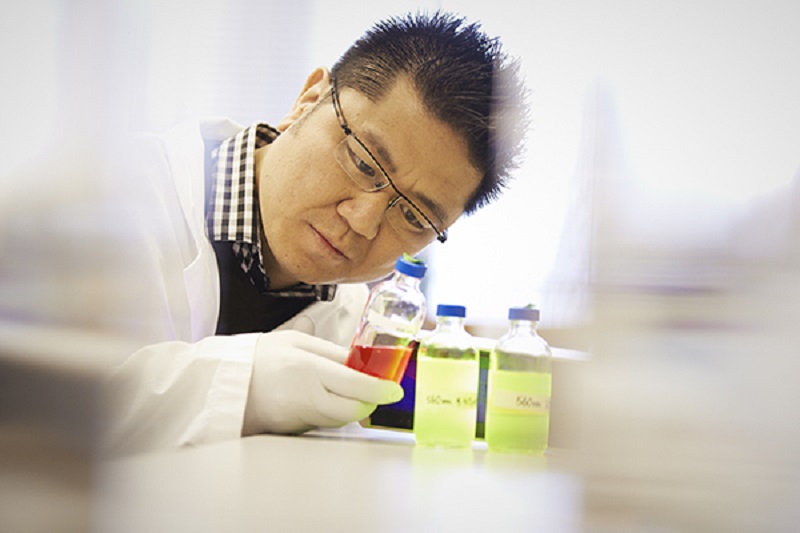Feb 22 2016
 Professor Warren Chan (IBBME, ChemE, MSE) has spent the last decade figuring out how to deliver chemotherapy drugs into tumours — and nowhere else. Now his lab has designed a set of nanoparticles attached to strands of DNA that can change shape to gain access to diseased tissue. (Photo credit: NSERC)
Professor Warren Chan (IBBME, ChemE, MSE) has spent the last decade figuring out how to deliver chemotherapy drugs into tumours — and nowhere else. Now his lab has designed a set of nanoparticles attached to strands of DNA that can change shape to gain access to diseased tissue. (Photo credit: NSERC)
The aim of chemotherapy should be to kill cancer cells without the side effect of hair falling out. A team of researchers from the University of Toronto have developed a novel molecular delivery system, which has the capability to ensure that chemotherapy drugs reach their target without major collateral damage.
A number of cancer drugs target rapidly developing cells. The drug is injected into a patient, where it moves along the bloodstream acting on the rapidly developing cells wherever it spots them. This would also include tumors, and unfortunately hair follicles, the lining of the digestive system, and skin.
Over the last 10 years, Professor Warren Chan (IBBME, ChemE, MSE) has focused on how to deliver chemotherapy drugs only to tumors and not anywhere else. His laboratory has created a set of nanoparticles attached to strands of DNA, which can alter shape to gain entry into diseased tissue.
Your body is basically a series of compartments. Think of it as a giant house with rooms inside. We’re trying to figure out how to get something that’s outside, into one specific room. One has to develop a map and a system that can move through the house where each path to the final room may have different restrictions such as height and width.
Professor Warren Chan, IBBME, ChemE, MSE
With cancer no two tumors are the same. For instance, early-stage breast cancer may respond differently to a particular treatment than pancreatic cancer.
Several factors such as the shape, surface chemistry, and size influence which particles are likely to enter a particular tumor. Chan and his team studied how these factors influence the delivery of nanotechnologies, and small molecules to the tumors. They have built the targeted molecular delivery system, which uses modular nanoparticles. The chemistry, size and shape of the modular nanoparticles can be modified by the presence of definite DNA sequences.
We’re making shape-changing nanoparticles. They’re a series of building blocks, kind of like a LEGO set.
Professor Warren Chan, IBBME, ChemE, MSE
The component pieces can be constructed into several shapes, with binding sites hidden or exposed. These pieces are configured to react to biological molecules by altering their shape, similar to a key fitting into a lock. The shape-shifters comprise of tiny pieces of metal with strands of DNA attached to them. Chan predicts that the nanoparticles are harmless, and will float around in the blood stream until the nanoparticles DNA strand attaches to a sequence of DNA proven to be a marker for cancer. When this occurs, the particle alters shape and begins to act. According to the task designed by Chan’s team, the nanoparticle may target the cancer cells, tag the cancerous cells with a signal molecule, or expose a drug molecule to a cancerous cell.
University of Toronto’s research has been published in the Proceedings of the National Academy of Sciences and the Science journal.
We were inspired by the ability of proteins to alter their conformation — they somehow figure out how to alleviate all these delivery issues inside the body. Using this idea, we thought, ‘Can we engineer a nanoparticle to function like a protein, but one that can be programmed outside the body with medical capabilities?
Professor Warren Chan, IBBME, ChemE, MSE
Although using materials science and nanotechnology in the field of medicine is quite a new concept, Chan believes that it holds huge potential. The real challenge now will be to find a way to deliver an adequate quantity of the nanoparticles directly to the cancer to generate an effective treatment.
Here’s how we look at these problems: it’s like you’re going to Vancouver from Toronto, but no one tells you how to get there, no one gives you a map, or a plane ticket, or a car — that’s where we are in this field. The idea of targeting drugs to tumors is like figuring out how to go to Vancouver. It’s a simple concept, but to get there isn’t simple if not enough information is provided. We’ve only scratched the surface of how nanotechnology ‘delivery’ works in the body, so now we’re continuing to explore different details of why and how tumors and other organs allow or block certain things from getting in.
Professor Warren Chan, IBBME, ChemE, MSE
Going forward, Chan’s team plan to use its delivery system in customized nanomedicine, which would further tailor the particles to deliver drugs to specific type of tumor without entering any other area.